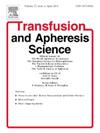Pathogen-reduction technology, good in more than one way for cellular blood components, is replacing irradiation
IF 1.4
4区 医学
Q4 HEMATOLOGY
引用次数: 0
Abstract
Clinical application of pathogen-reduction technology (PRT) is often restricted to platelet and non-cellular components, representing a minor fraction of the overall blood supply. The greatest benefit for patient safety may eventually derive from PRT in red cells, which is still unavailable for routine use. PRT is more effective to inactivate leukocytes than current irradiation, particularly pertinent for Japan with the only universal irradiation of cellular blood components. Elsewhere, only vulnerable patient cohorts are receiving irradiated cellular components. Blood components treated with approved PRT systems are exempt from irradiation if the patient requires irradiated components. Transfusion medicine has a strategic opportunity to develop and eventually utilize PRT for all cellular components, other than hematopoietic progenitor cell products. PRT would then enable leukocyte inactivation for 100 % of the blood supply, beneficial for transfusion safety in all patients.
对细胞血液成分有多种好处的病原体减少技术正在取代辐照
临床应用的病原体减少技术(PRT)往往仅限于血小板和非细胞成分,占整体血液供应的一小部分。对患者安全的最大益处可能最终来自红细胞中的PRT,目前仍无法用于常规使用。PRT比目前的辐照更有效地灭活白细胞,尤其适用于日本,因为日本只有细胞血液成分的普遍辐照。在其他地方,只有脆弱的患者队列接受辐照细胞成分。经批准的PRT系统处理的血液成分,如果患者需要辐照成分,则免除辐照。输血医学具有发展并最终将PRT用于除造血祖细胞产品以外的所有细胞成分的战略机遇。然后,PRT将使100% %的血液供应中的白细胞失活,有利于所有患者的输血安全。
本文章由计算机程序翻译,如有差异,请以英文原文为准。
求助全文
约1分钟内获得全文
求助全文
来源期刊
CiteScore
3.60
自引率
5.30%
发文量
181
审稿时长
42 days
期刊介绍:
Transfusion and Apheresis Science brings comprehensive and up-to-date information to physicians and health care professionals involved in the rapidly changing fields of transfusion medicine, hemostasis and apheresis. The journal presents original articles relating to scientific and clinical studies in the areas of immunohematology, transfusion practice, bleeding and thrombotic disorders and both therapeutic and donor apheresis including hematopoietic stem cells. Topics covered include the collection and processing of blood, compatibility testing and guidelines for the use of blood products, as well as screening for and transmission of blood-borne diseases. All areas of apheresis - therapeutic and collection - are also addressed. We would like to specifically encourage allied health professionals in this area to submit manuscripts that relate to improved patient and donor care, technical aspects and educational issues.
Transfusion and Apheresis Science features a "Theme" section which includes, in each issue, a group of papers designed to review a specific topic of current importance in transfusion and hemostasis for the discussion of topical issues specific to apheresis and focuses on the operators'' viewpoint. Another section is "What''s Happening" which provides informal reporting of activities in the field. In addition, brief case reports and Letters to the Editor, as well as reviews of meetings and events of general interest, and a listing of recent patents make the journal a complete source of information for practitioners of transfusion, hemostasis and apheresis science. Immediate dissemination of important information is ensured by the commitment of Transfusion and Apheresis Science to rapid publication of both symposia and submitted papers.

 求助内容:
求助内容: 应助结果提醒方式:
应助结果提醒方式:


